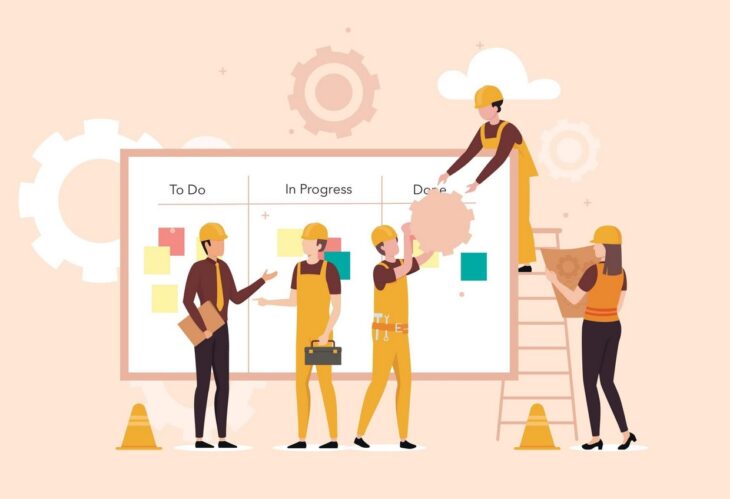When you are planning a big construction project – there are a lot of bases to cover. From budgets to personnel and the project itself, the more you plan, the better. And for larger projects, there’s even more of a focus on the planning process as there will be so many more tasks involved.
For large-scale projects, you could even look into using a construction management software like safesitecheckin.com or hiring a construction management company like compass-pc.com to handle all of the oversight and supervision for your project to ensure that things run as smoothly and efficiently as possible. For companies who lack experience in construction or don’t have the right skills in their team, then outsourcing planning expertise can really make a difference to your construction project.

Source: Twproject
Contents
Why planning is important
Before we get into how you can plan for your construction project, let’s look at why this process is so vital. Planning is a crucial part of any construction project because it determines the success of your project, but there are many other factors that make this a non-negotiable step in a project of any size.
It defines the scope of your project
Without planning, there is no way of knowing what your company can achieve. Planning allows us to get a detailed, realistic picture of what the project can accomplish, by taking into account all the possible factors available to us.
Once you know the capabilities of your business and team, you can take meaningful and specific steps to make your project come to fruition.
In the event that you’ve been a little too ambitious with your plans, the planning process will highlight these areas and allow you to either scale back in certain areas or outsource more resources. If you’re working for a client then this is even more important, as you don’t want to give them an invoice that they’re not prepared to pay.

Source: CIO.com
You get the best ideas
Planning your project rather than diving straight into things means that you’ll be able to take stock and brainstorm with your team. Doing so will help you to generate new ideas and ways of doing things that you wouldn’t have necessarily done before.
The reality is that many companies have best practices and processes in place that simply aren’t the most effective option. When you plan each step of the project, you can use the opportunity to evaluate whether your team is working as efficiently as possible, and improve on your processes there and then.
You’ll never know what to do 100% of the time in a project. Planning means that you can share any issues or uncertainties with your team members, and they can help to think of solutions and improvements. This minimises any potential speed bumps along the way of the project.
It’s cost-effective
Budgeting your project is a crucial part of planning as the whole project is impossible to complete without the necessary financial resources. It’s in the planning process that cost-management techniques can be employed to help to keep costs down.
Planning for a project also involves contingency planning. It’s inevitable that something may come up unexpectedly during the lifespan of the project, and planning is the best way to minimise the impact of potential mistakes or delays. And delays and mistakes cost money, so planning ahead helps to keep costs down.

Source: BBVA
How to plan for your project
Now you know why planning is so important for your project, it’s time to understand each step of the planning process. This will allow you to cover all of your bases and ensure that each and every task is accounted for.
Flesh out initial ideas
As the first step of planning your project, fleshing out initial ideas is a very fluid, creative process. While you may know what the overall goal is, you can use brainstorming techniques to work out how to achieve that goal in an effective, creative way.
This is the time where you’ll focus on designs, themes, and the overall vision of the project. You may decide here that you need some extra help from a third party construction consultancy and make any necessary enquiries.

Source: Hygger
Create a realistic plan
Once you have settled on your overall goal or outcome for the project, you can move onto the next step of creating the plan itself for the construction of your project. Here you’ll get the designs for the project drawn up, start thinking about budgets and personnel and work out rough timelines.
If you’re working with or for a client, you’ll need to liaise with the relevant stakeholders to ensure that everything is in order and everyone is happy with the project.
Pick your personnel
Once all the overall plans are in place, it’s time to pick your team. Getting the personnel for your project right is absolutely essential as the people involved in the whole process will make or break the project.
It’s a good practice to pick your team based on their skills rather than anything else so that the work and quality is always the top priority.

Source: moneycrashers
Work out your budget
Without the right funding, your project won’t be able to be completed, making this step an indispensable one. There are many different ways to approach budgeting:
- Zero-based budgeting. Managers for each department must work out what their predicted budget will be and justify it to the financial manager.
- Incremental budgeting. Taking your past project’s budgets and increasing the budget on them incrementally.
- Activity-based budgeting. This method sees each activity that is needed to complete the project be budgeted for individually.
Take out any actions on the plan
Throughout the planning process, you will have a number of tasks that need to be carried out before construction can start. This could be anything from site management to getting the correct permits and resources. These things are vital to the success of your project and will contribute to the success of the project overall.

Source: Rhumbix
Start construction
Once all the planning has been done, it’s time to start your project! When you have a thorough and well-thought-out plan, your project has a great chance of success. However, it’s important to keep in mind that things can change, so while your plan should be stuck to as closely as possible, you should try to be as adaptable as possible.
